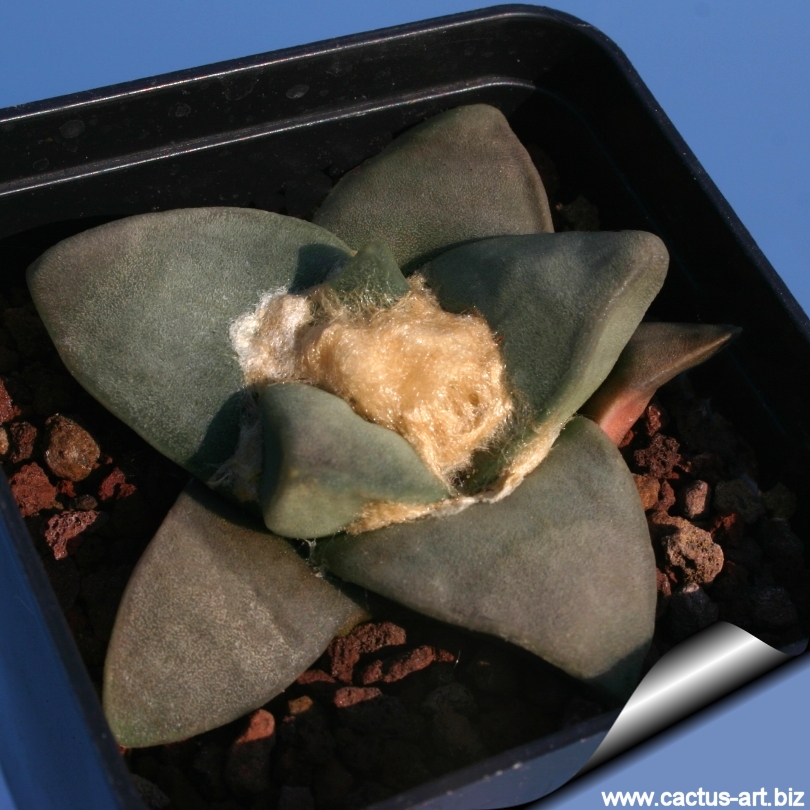|
|
|

Ariocarpus retusus (furfuraceus) forma major (cv. TAMA
BOTAN).
This is a choice and very priced form with very wide tubercles
selected by Japanese growers.
|
|
Description: The standard A. retusus
is a solitary, slow growing
geophyte cactus with tubercles slightly projecting above ground
level. The "major" form is a cultivated selection with very wide
leaflike, divergent tubercles.
Tubercles: The wide smooth tubercles, with flat surface are the
main distinctive characteristic of this priced form, they are 3,5 to 5
cm wide, and are as wide
as long or wider in adult specimens.
Stem: Grey, or blue-green, flattened, globose, rounded on top,
3-12cm high, 20-30 cm in diameter.
Flowers: Diurnal 4-5cm in diameter., 2-4 2cm long; white to pink,
occasionally with reddish midribs,
Root: Tap root
Flowering time: October
Fruit: White, green, or rarely pinkish, 10-25mm long, 3-10mm in
diameter.
Photo of conspecific taxa, varieties, forms and cultivars of
Ariocarpus retusus.
|
|

 |
|
Advertising
|
|
|
|
|
Family:
Cactaceae (Cactus
Family)
Scientific name:
Ariocarpus retusus Scheidweiler, (1838)
Pubblished in: Bull. Acad. Sci. Brux. 5: 492
"major" (cv. TAMA BOTAN)
Conservation status: Listed in
CITES Appendix I
Synonyms:
- Anhalonium prismaticum Lemaire
1839
= Mammillaria prismatica
- Ariocarpus elongatus Lee 1937Scientific
= Anhalonium elongatum Salm-Dyck 1850
- Ariocarpus pulvilligeris
- Anhalonium areolosum,
Common name: Living Rock, Seven Stars
Origin:
Garden origin (Nursery
produced cultivar) Japan.
Ariocarpus retusus is an extremely
variable species,. Tubercle size and shape vary widely, a terminal
areole is sometimes present at the tip. The vast amount of phenotypic
variation in the species has led to the erection of several variants:
- A. retusus ssp. retusus: widespread, flowers are cream or
white, occasionally with reddish midveins.
- A. retusus ssp. trigonus: somewhat less widespread
with long sharp tubercles twice as long as wide. The flowers are
yellow (usually), white to pinkish white.
- A. retusus v. furfuraceus: applied to plants with
equilaterally triangular shaped tubercles
- A. retusus ‘furfuraceus’ var. rostratus refers to
plants with a more tapered apex to the tubercle.
- A. retusus v. scapharostroides plants from the Villa
Juarez region of SLP, it is characterized by erect angular tubercles,
superficially reminiscent of A. scapharostrus.
- A. retusus confusus nomina nuda
- A. retusus subsp. jarmilae nomina nuda
- A. retusus subsp. horaceki nomina nuda
- A. retusus var. pectinatus nomina nuda
- A. retusus subsp. panarottoi nomina nuda
- A retusus var. minimus is a nomina nuda which has
recently been applied to plants from Echido Nuncio,in San Luis Potosi.
- A. retusus f. major applied to selected cultivated
plants with very broad shaped tubercles (“Tama-botan” in
Japan).
|
|
|
|
Cultivation: This species is slow growing but
certainly not as slow as some other types of cacti, it is of easy
culture in a well drained, non-organic,
free-draining soil compost, with ample water
during the growing season. Use of a weak
low-nitrogen fertilizer during the growing season can
encourage growth. The main threat to their development is root rot.
Ariocarpus should be kept dry whenever there is a threat of cold. The
appearance of Ariocarpus can benefit greatly by watering the plants from
the bottom. This practice will help to keep the “wool” on the top of the
plant from becoming matted or discoloured. Need light shade to full sun.
Frost Tolerance: Hardy to -10° C
Propagation: It is probably the easiest species of the genus to
raise from seed, but will generally take about 6-10 years to reach
flowering size, occasionally grafted.
The pointed tubercles are usually smooth with areoles.
|
|